Business Revenue Units and Strategies of Yield Melbourne Company
VerifiedAdded on 2023/01/11
|10
|2377
|87
AI Summary
This paper discusses the business revenue units and strategies used by the Yield Melbourne Company, an agricultural technology firm in Australia. It explores the importance of sales revenue unit, business level strategies, PESTLE analysis, and Porter's analysis in the company's operations.
Contribute Materials
Your contribution can guide someone’s learning journey. Share your
documents today.
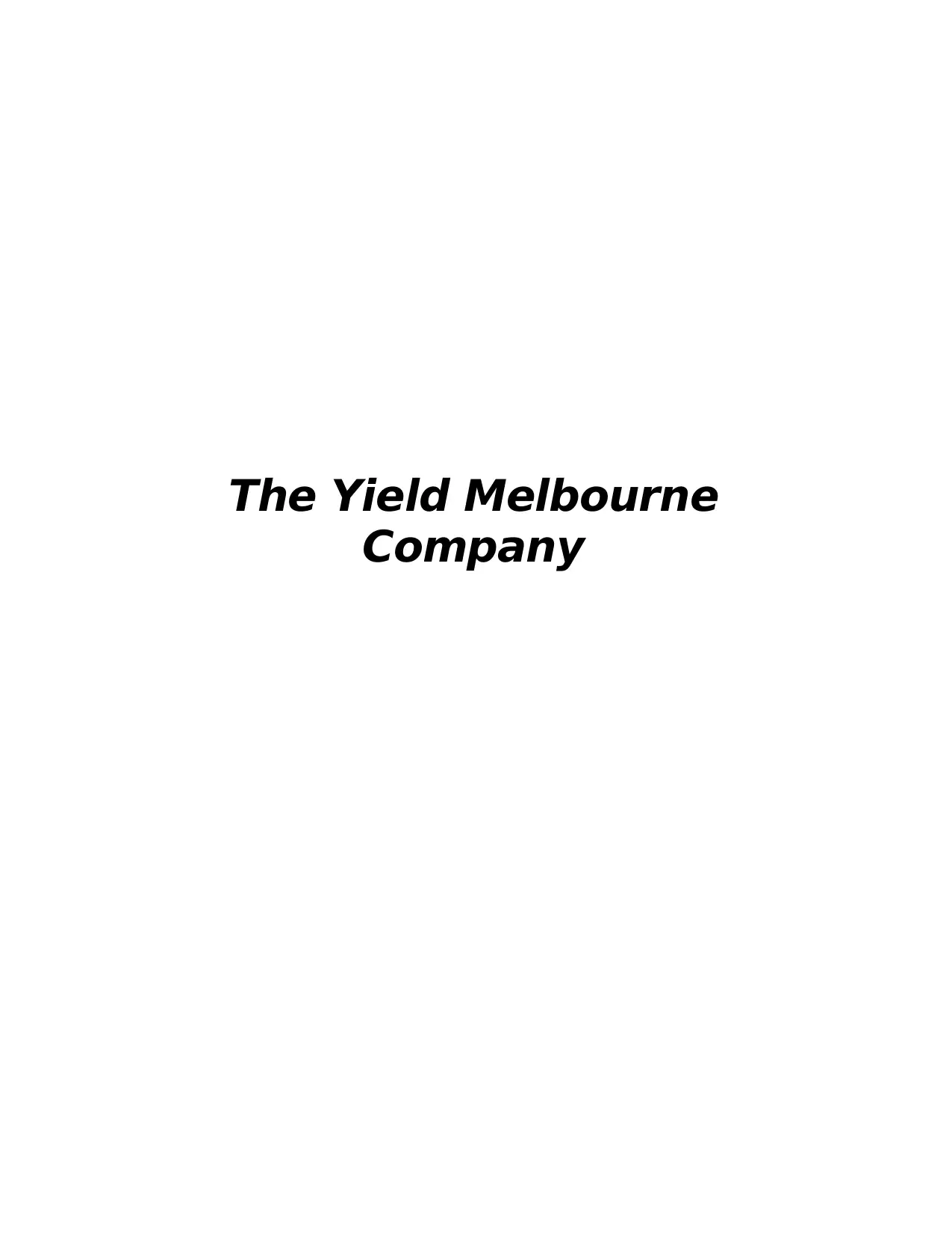
The Yield Melbourne
Company
Company
Secure Best Marks with AI Grader
Need help grading? Try our AI Grader for instant feedback on your assignments.
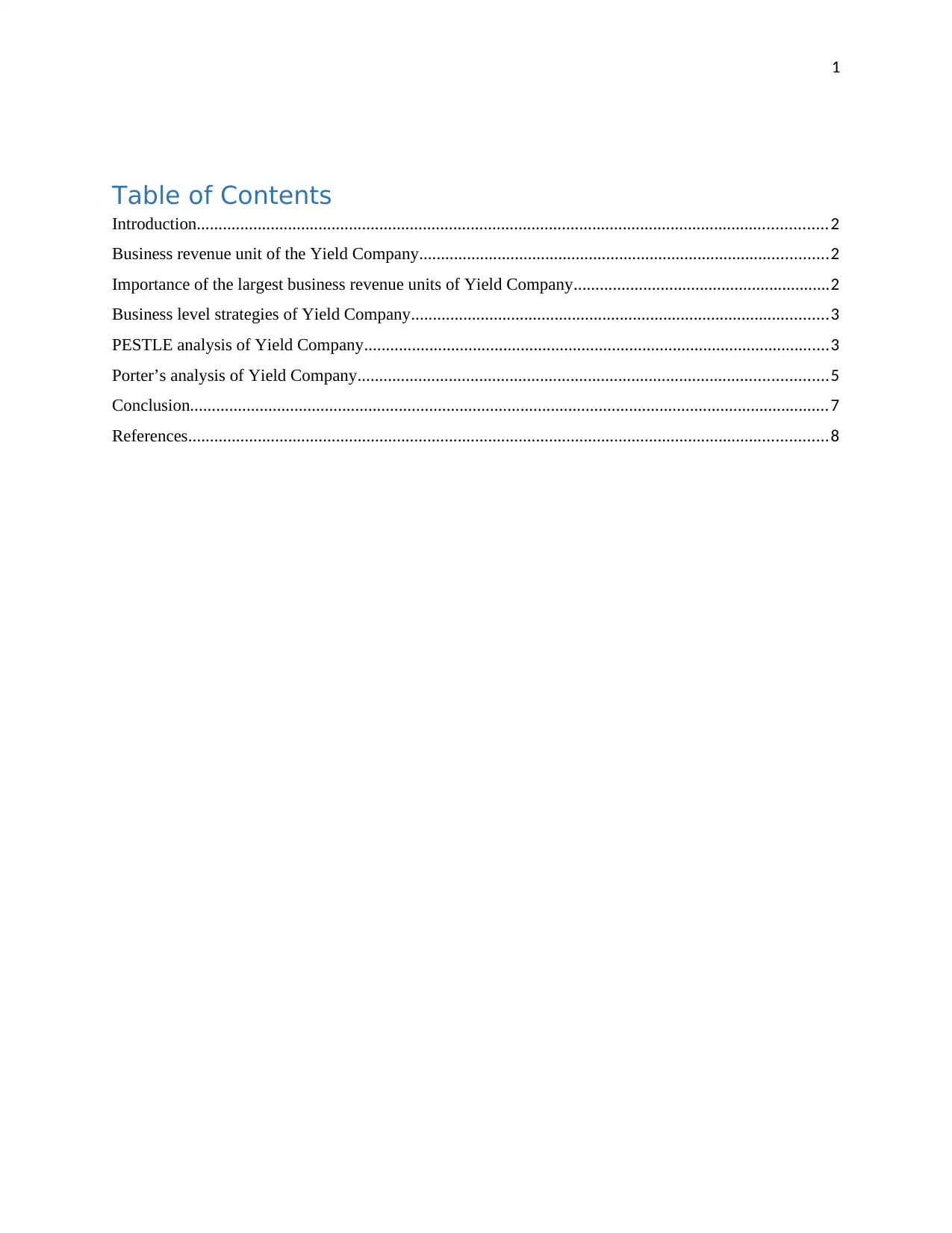
1
Table of Contents
Introduction.................................................................................................................................................2
Business revenue unit of the Yield Company..............................................................................................2
Importance of the largest business revenue units of Yield Company...........................................................2
Business level strategies of Yield Company................................................................................................3
PESTLE analysis of Yield Company...........................................................................................................3
Porter’s analysis of Yield Company............................................................................................................5
Conclusion...................................................................................................................................................7
References...................................................................................................................................................8
Table of Contents
Introduction.................................................................................................................................................2
Business revenue unit of the Yield Company..............................................................................................2
Importance of the largest business revenue units of Yield Company...........................................................2
Business level strategies of Yield Company................................................................................................3
PESTLE analysis of Yield Company...........................................................................................................3
Porter’s analysis of Yield Company............................................................................................................5
Conclusion...................................................................................................................................................7
References...................................................................................................................................................8
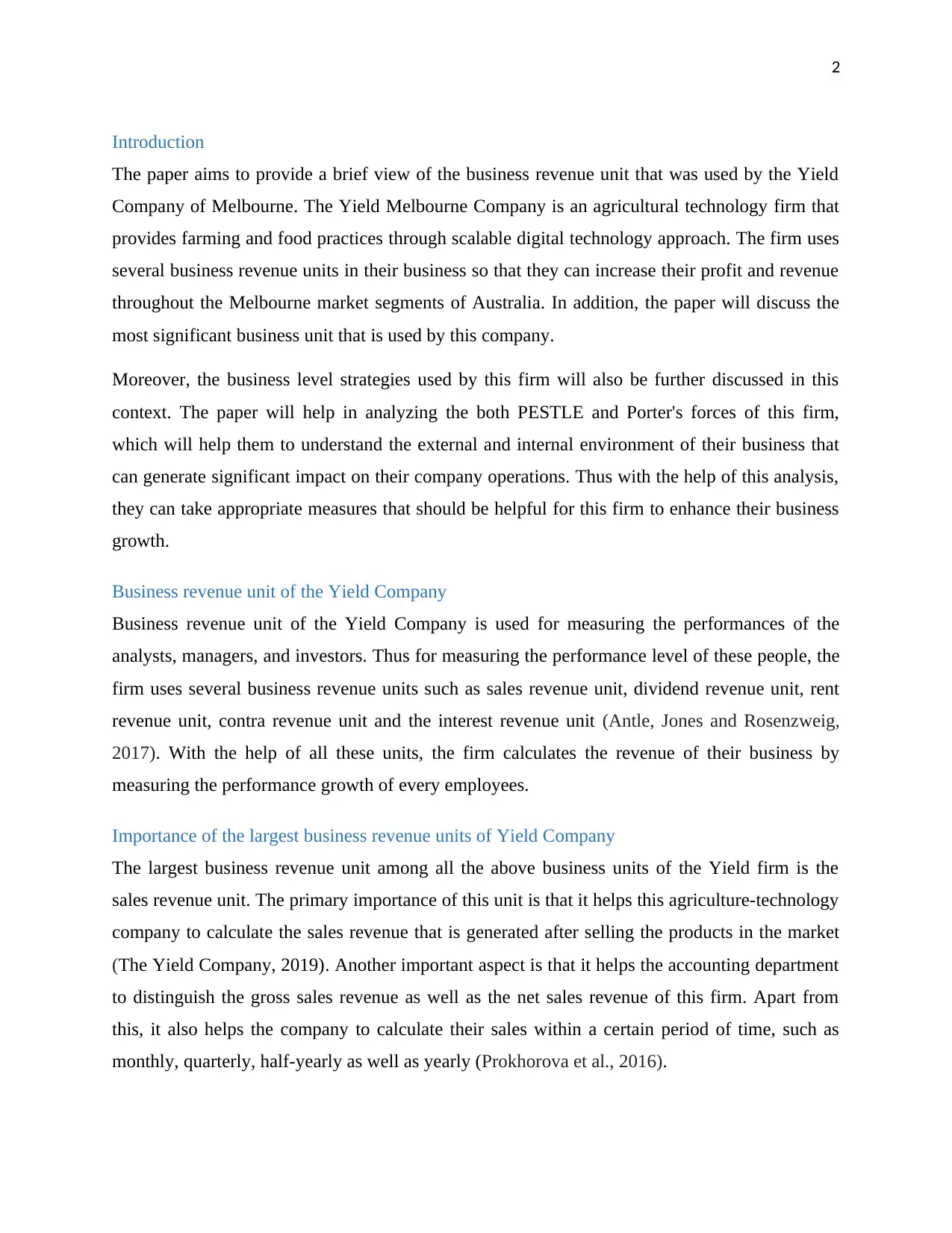
2
Introduction
The paper aims to provide a brief view of the business revenue unit that was used by the Yield
Company of Melbourne. The Yield Melbourne Company is an agricultural technology firm that
provides farming and food practices through scalable digital technology approach. The firm uses
several business revenue units in their business so that they can increase their profit and revenue
throughout the Melbourne market segments of Australia. In addition, the paper will discuss the
most significant business unit that is used by this company.
Moreover, the business level strategies used by this firm will also be further discussed in this
context. The paper will help in analyzing the both PESTLE and Porter's forces of this firm,
which will help them to understand the external and internal environment of their business that
can generate significant impact on their company operations. Thus with the help of this analysis,
they can take appropriate measures that should be helpful for this firm to enhance their business
growth.
Business revenue unit of the Yield Company
Business revenue unit of the Yield Company is used for measuring the performances of the
analysts, managers, and investors. Thus for measuring the performance level of these people, the
firm uses several business revenue units such as sales revenue unit, dividend revenue unit, rent
revenue unit, contra revenue unit and the interest revenue unit (Antle, Jones and Rosenzweig,
2017). With the help of all these units, the firm calculates the revenue of their business by
measuring the performance growth of every employees.
Importance of the largest business revenue units of Yield Company
The largest business revenue unit among all the above business units of the Yield firm is the
sales revenue unit. The primary importance of this unit is that it helps this agriculture-technology
company to calculate the sales revenue that is generated after selling the products in the market
(The Yield Company, 2019). Another important aspect is that it helps the accounting department
to distinguish the gross sales revenue as well as the net sales revenue of this firm. Apart from
this, it also helps the company to calculate their sales within a certain period of time, such as
monthly, quarterly, half-yearly as well as yearly (Prokhorova et al., 2016).
Introduction
The paper aims to provide a brief view of the business revenue unit that was used by the Yield
Company of Melbourne. The Yield Melbourne Company is an agricultural technology firm that
provides farming and food practices through scalable digital technology approach. The firm uses
several business revenue units in their business so that they can increase their profit and revenue
throughout the Melbourne market segments of Australia. In addition, the paper will discuss the
most significant business unit that is used by this company.
Moreover, the business level strategies used by this firm will also be further discussed in this
context. The paper will help in analyzing the both PESTLE and Porter's forces of this firm,
which will help them to understand the external and internal environment of their business that
can generate significant impact on their company operations. Thus with the help of this analysis,
they can take appropriate measures that should be helpful for this firm to enhance their business
growth.
Business revenue unit of the Yield Company
Business revenue unit of the Yield Company is used for measuring the performances of the
analysts, managers, and investors. Thus for measuring the performance level of these people, the
firm uses several business revenue units such as sales revenue unit, dividend revenue unit, rent
revenue unit, contra revenue unit and the interest revenue unit (Antle, Jones and Rosenzweig,
2017). With the help of all these units, the firm calculates the revenue of their business by
measuring the performance growth of every employees.
Importance of the largest business revenue units of Yield Company
The largest business revenue unit among all the above business units of the Yield firm is the
sales revenue unit. The primary importance of this unit is that it helps this agriculture-technology
company to calculate the sales revenue that is generated after selling the products in the market
(The Yield Company, 2019). Another important aspect is that it helps the accounting department
to distinguish the gross sales revenue as well as the net sales revenue of this firm. Apart from
this, it also helps the company to calculate their sales within a certain period of time, such as
monthly, quarterly, half-yearly as well as yearly (Prokhorova et al., 2016).
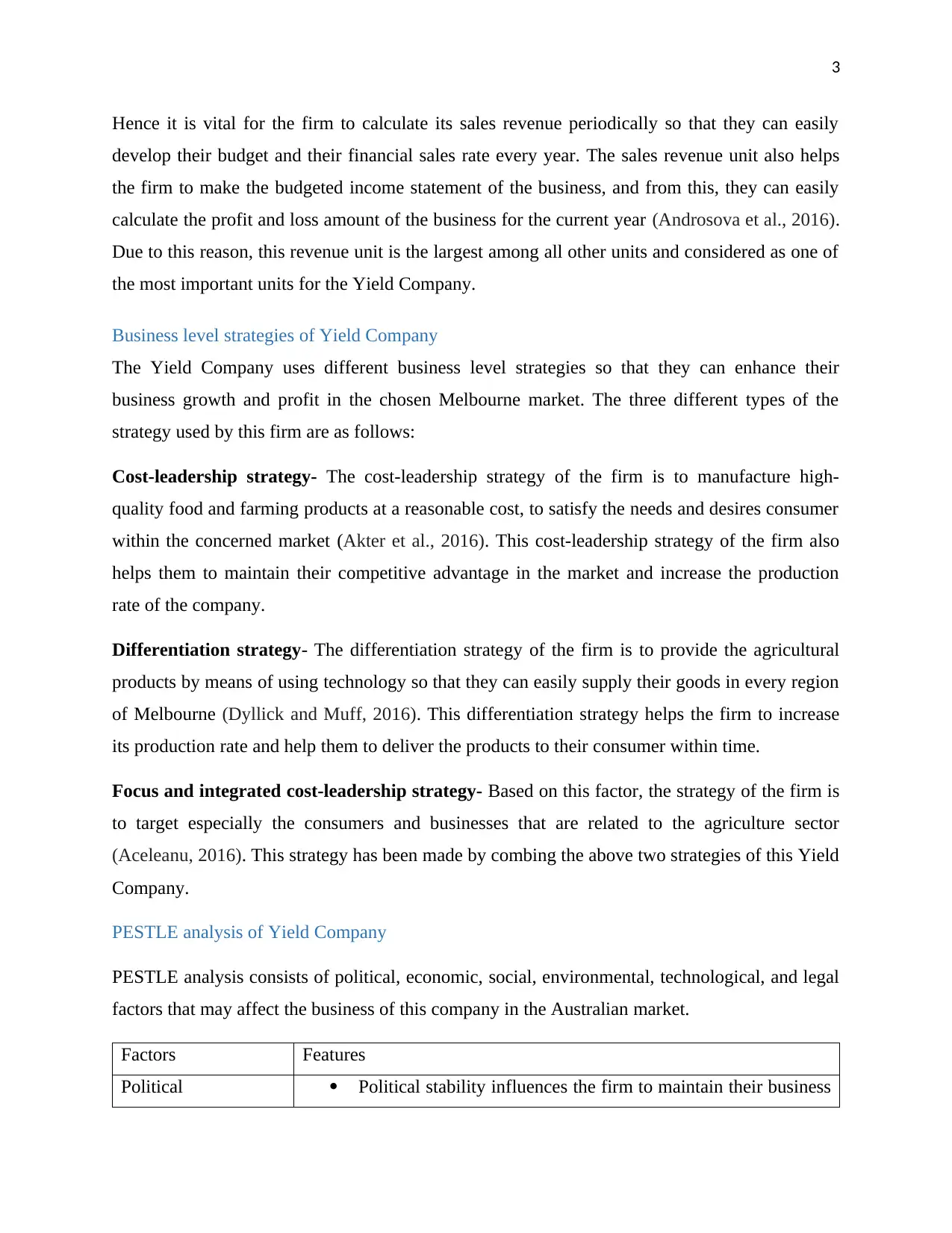
3
Hence it is vital for the firm to calculate its sales revenue periodically so that they can easily
develop their budget and their financial sales rate every year. The sales revenue unit also helps
the firm to make the budgeted income statement of the business, and from this, they can easily
calculate the profit and loss amount of the business for the current year (Androsova et al., 2016).
Due to this reason, this revenue unit is the largest among all other units and considered as one of
the most important units for the Yield Company.
Business level strategies of Yield Company
The Yield Company uses different business level strategies so that they can enhance their
business growth and profit in the chosen Melbourne market. The three different types of the
strategy used by this firm are as follows:
Cost-leadership strategy- The cost-leadership strategy of the firm is to manufacture high-
quality food and farming products at a reasonable cost, to satisfy the needs and desires consumer
within the concerned market (Akter et al., 2016). This cost-leadership strategy of the firm also
helps them to maintain their competitive advantage in the market and increase the production
rate of the company.
Differentiation strategy- The differentiation strategy of the firm is to provide the agricultural
products by means of using technology so that they can easily supply their goods in every region
of Melbourne (Dyllick and Muff, 2016). This differentiation strategy helps the firm to increase
its production rate and help them to deliver the products to their consumer within time.
Focus and integrated cost-leadership strategy- Based on this factor, the strategy of the firm is
to target especially the consumers and businesses that are related to the agriculture sector
(Aceleanu, 2016). This strategy has been made by combing the above two strategies of this Yield
Company.
PESTLE analysis of Yield Company
PESTLE analysis consists of political, economic, social, environmental, technological, and legal
factors that may affect the business of this company in the Australian market.
Factors Features
Political Political stability influences the firm to maintain their business
Hence it is vital for the firm to calculate its sales revenue periodically so that they can easily
develop their budget and their financial sales rate every year. The sales revenue unit also helps
the firm to make the budgeted income statement of the business, and from this, they can easily
calculate the profit and loss amount of the business for the current year (Androsova et al., 2016).
Due to this reason, this revenue unit is the largest among all other units and considered as one of
the most important units for the Yield Company.
Business level strategies of Yield Company
The Yield Company uses different business level strategies so that they can enhance their
business growth and profit in the chosen Melbourne market. The three different types of the
strategy used by this firm are as follows:
Cost-leadership strategy- The cost-leadership strategy of the firm is to manufacture high-
quality food and farming products at a reasonable cost, to satisfy the needs and desires consumer
within the concerned market (Akter et al., 2016). This cost-leadership strategy of the firm also
helps them to maintain their competitive advantage in the market and increase the production
rate of the company.
Differentiation strategy- The differentiation strategy of the firm is to provide the agricultural
products by means of using technology so that they can easily supply their goods in every region
of Melbourne (Dyllick and Muff, 2016). This differentiation strategy helps the firm to increase
its production rate and help them to deliver the products to their consumer within time.
Focus and integrated cost-leadership strategy- Based on this factor, the strategy of the firm is
to target especially the consumers and businesses that are related to the agriculture sector
(Aceleanu, 2016). This strategy has been made by combing the above two strategies of this Yield
Company.
PESTLE analysis of Yield Company
PESTLE analysis consists of political, economic, social, environmental, technological, and legal
factors that may affect the business of this company in the Australian market.
Factors Features
Political Political stability influences the firm to maintain their business
Paraphrase This Document
Need a fresh take? Get an instant paraphrase of this document with our AI Paraphraser
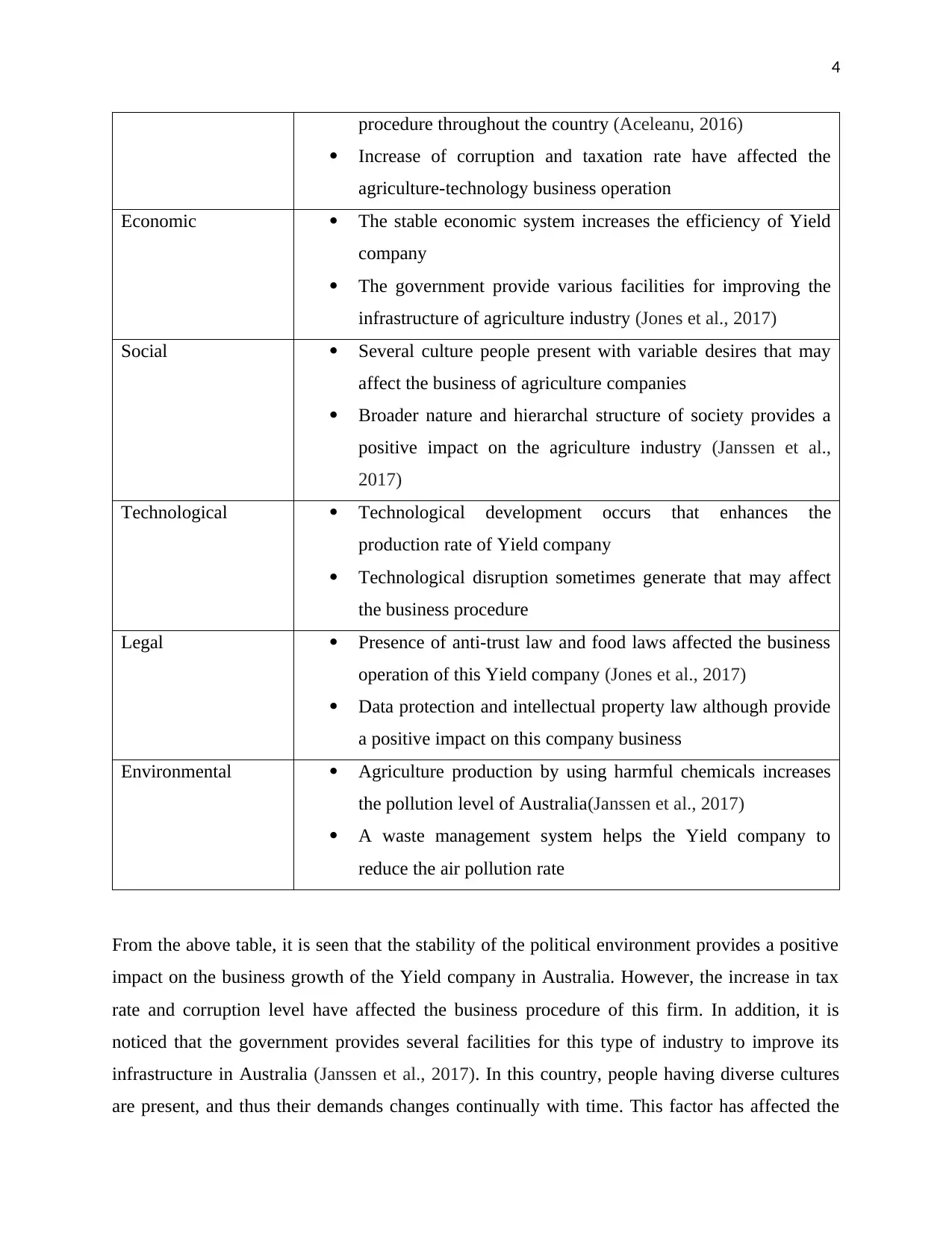
4
procedure throughout the country (Aceleanu, 2016)
Increase of corruption and taxation rate have affected the
agriculture-technology business operation
Economic The stable economic system increases the efficiency of Yield
company
The government provide various facilities for improving the
infrastructure of agriculture industry (Jones et al., 2017)
Social Several culture people present with variable desires that may
affect the business of agriculture companies
Broader nature and hierarchal structure of society provides a
positive impact on the agriculture industry (Janssen et al.,
2017)
Technological Technological development occurs that enhances the
production rate of Yield company
Technological disruption sometimes generate that may affect
the business procedure
Legal Presence of anti-trust law and food laws affected the business
operation of this Yield company (Jones et al., 2017)
Data protection and intellectual property law although provide
a positive impact on this company business
Environmental Agriculture production by using harmful chemicals increases
the pollution level of Australia(Janssen et al., 2017)
A waste management system helps the Yield company to
reduce the air pollution rate
From the above table, it is seen that the stability of the political environment provides a positive
impact on the business growth of the Yield company in Australia. However, the increase in tax
rate and corruption level have affected the business procedure of this firm. In addition, it is
noticed that the government provides several facilities for this type of industry to improve its
infrastructure in Australia (Janssen et al., 2017). In this country, people having diverse cultures
are present, and thus their demands changes continually with time. This factor has affected the
procedure throughout the country (Aceleanu, 2016)
Increase of corruption and taxation rate have affected the
agriculture-technology business operation
Economic The stable economic system increases the efficiency of Yield
company
The government provide various facilities for improving the
infrastructure of agriculture industry (Jones et al., 2017)
Social Several culture people present with variable desires that may
affect the business of agriculture companies
Broader nature and hierarchal structure of society provides a
positive impact on the agriculture industry (Janssen et al.,
2017)
Technological Technological development occurs that enhances the
production rate of Yield company
Technological disruption sometimes generate that may affect
the business procedure
Legal Presence of anti-trust law and food laws affected the business
operation of this Yield company (Jones et al., 2017)
Data protection and intellectual property law although provide
a positive impact on this company business
Environmental Agriculture production by using harmful chemicals increases
the pollution level of Australia(Janssen et al., 2017)
A waste management system helps the Yield company to
reduce the air pollution rate
From the above table, it is seen that the stability of the political environment provides a positive
impact on the business growth of the Yield company in Australia. However, the increase in tax
rate and corruption level have affected the business procedure of this firm. In addition, it is
noticed that the government provides several facilities for this type of industry to improve its
infrastructure in Australia (Janssen et al., 2017). In this country, people having diverse cultures
are present, and thus their demands changes continually with time. This factor has affected the
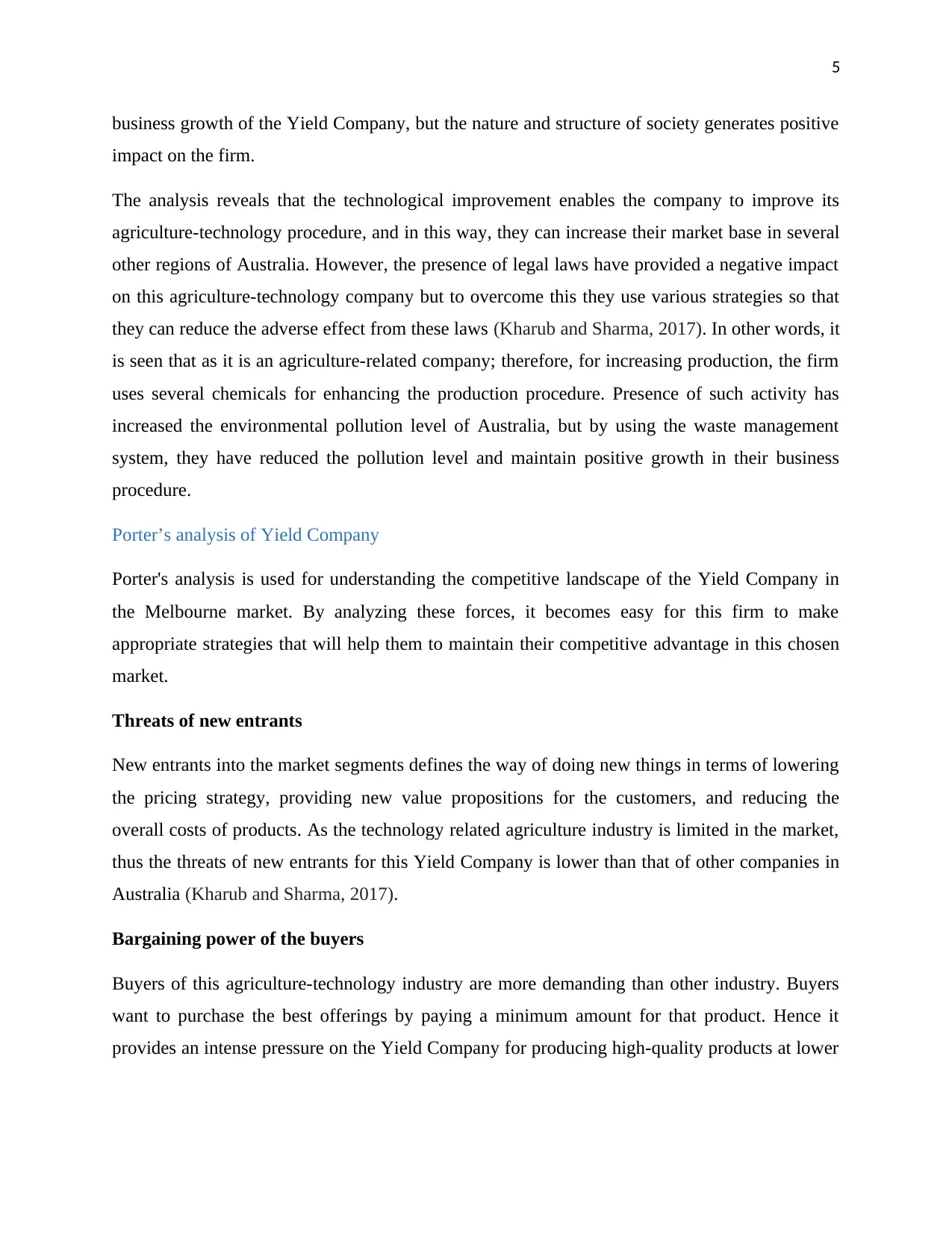
5
business growth of the Yield Company, but the nature and structure of society generates positive
impact on the firm.
The analysis reveals that the technological improvement enables the company to improve its
agriculture-technology procedure, and in this way, they can increase their market base in several
other regions of Australia. However, the presence of legal laws have provided a negative impact
on this agriculture-technology company but to overcome this they use various strategies so that
they can reduce the adverse effect from these laws (Kharub and Sharma, 2017). In other words, it
is seen that as it is an agriculture-related company; therefore, for increasing production, the firm
uses several chemicals for enhancing the production procedure. Presence of such activity has
increased the environmental pollution level of Australia, but by using the waste management
system, they have reduced the pollution level and maintain positive growth in their business
procedure.
Porter’s analysis of Yield Company
Porter's analysis is used for understanding the competitive landscape of the Yield Company in
the Melbourne market. By analyzing these forces, it becomes easy for this firm to make
appropriate strategies that will help them to maintain their competitive advantage in this chosen
market.
Threats of new entrants
New entrants into the market segments defines the way of doing new things in terms of lowering
the pricing strategy, providing new value propositions for the customers, and reducing the
overall costs of products. As the technology related agriculture industry is limited in the market,
thus the threats of new entrants for this Yield Company is lower than that of other companies in
Australia (Kharub and Sharma, 2017).
Bargaining power of the buyers
Buyers of this agriculture-technology industry are more demanding than other industry. Buyers
want to purchase the best offerings by paying a minimum amount for that product. Hence it
provides an intense pressure on the Yield Company for producing high-quality products at lower
business growth of the Yield Company, but the nature and structure of society generates positive
impact on the firm.
The analysis reveals that the technological improvement enables the company to improve its
agriculture-technology procedure, and in this way, they can increase their market base in several
other regions of Australia. However, the presence of legal laws have provided a negative impact
on this agriculture-technology company but to overcome this they use various strategies so that
they can reduce the adverse effect from these laws (Kharub and Sharma, 2017). In other words, it
is seen that as it is an agriculture-related company; therefore, for increasing production, the firm
uses several chemicals for enhancing the production procedure. Presence of such activity has
increased the environmental pollution level of Australia, but by using the waste management
system, they have reduced the pollution level and maintain positive growth in their business
procedure.
Porter’s analysis of Yield Company
Porter's analysis is used for understanding the competitive landscape of the Yield Company in
the Melbourne market. By analyzing these forces, it becomes easy for this firm to make
appropriate strategies that will help them to maintain their competitive advantage in this chosen
market.
Threats of new entrants
New entrants into the market segments defines the way of doing new things in terms of lowering
the pricing strategy, providing new value propositions for the customers, and reducing the
overall costs of products. As the technology related agriculture industry is limited in the market,
thus the threats of new entrants for this Yield Company is lower than that of other companies in
Australia (Kharub and Sharma, 2017).
Bargaining power of the buyers
Buyers of this agriculture-technology industry are more demanding than other industry. Buyers
want to purchase the best offerings by paying a minimum amount for that product. Hence it
provides an intense pressure on the Yield Company for producing high-quality products at lower
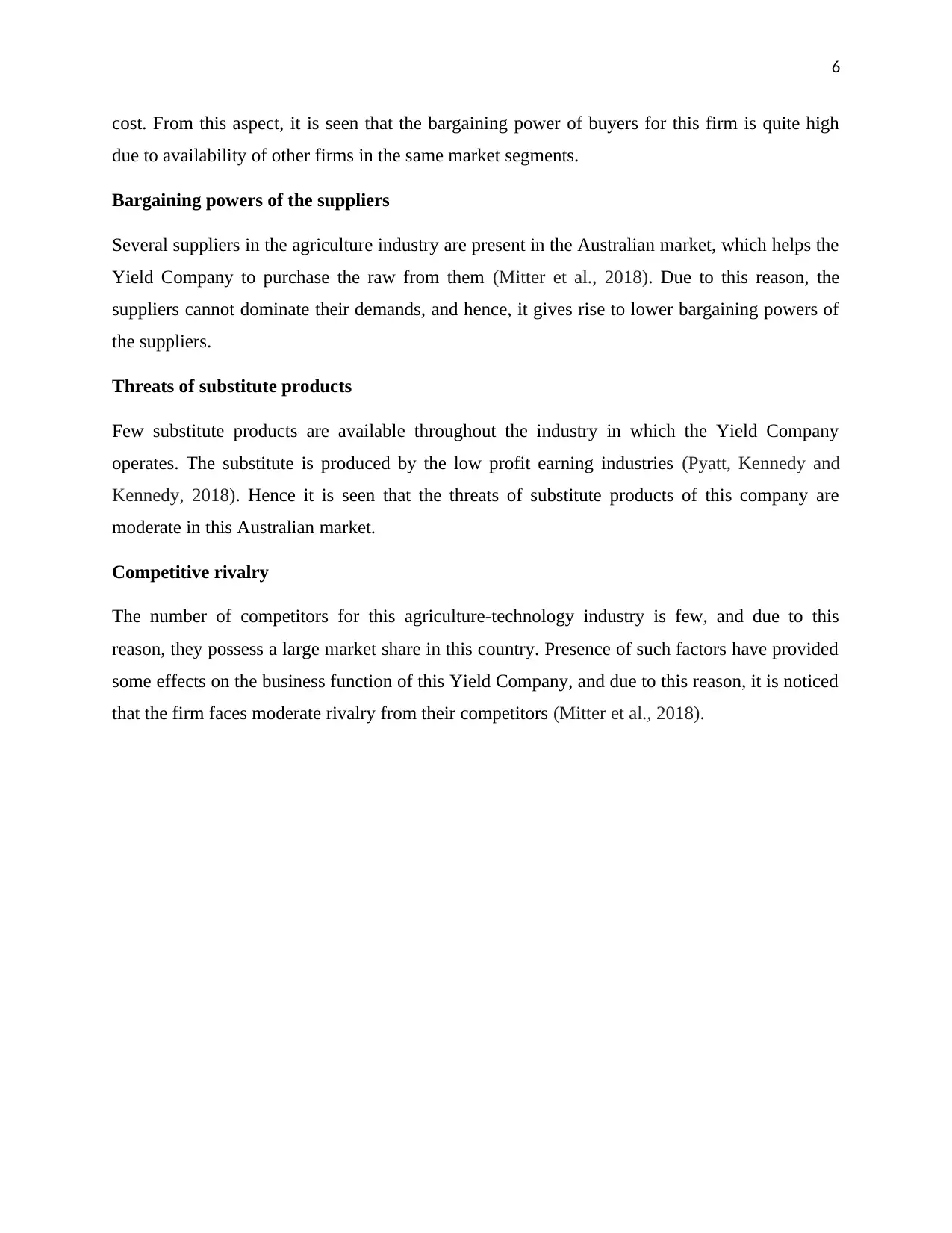
6
cost. From this aspect, it is seen that the bargaining power of buyers for this firm is quite high
due to availability of other firms in the same market segments.
Bargaining powers of the suppliers
Several suppliers in the agriculture industry are present in the Australian market, which helps the
Yield Company to purchase the raw from them (Mitter et al., 2018). Due to this reason, the
suppliers cannot dominate their demands, and hence, it gives rise to lower bargaining powers of
the suppliers.
Threats of substitute products
Few substitute products are available throughout the industry in which the Yield Company
operates. The substitute is produced by the low profit earning industries (Pyatt, Kennedy and
Kennedy, 2018). Hence it is seen that the threats of substitute products of this company are
moderate in this Australian market.
Competitive rivalry
The number of competitors for this agriculture-technology industry is few, and due to this
reason, they possess a large market share in this country. Presence of such factors have provided
some effects on the business function of this Yield Company, and due to this reason, it is noticed
that the firm faces moderate rivalry from their competitors (Mitter et al., 2018).
cost. From this aspect, it is seen that the bargaining power of buyers for this firm is quite high
due to availability of other firms in the same market segments.
Bargaining powers of the suppliers
Several suppliers in the agriculture industry are present in the Australian market, which helps the
Yield Company to purchase the raw from them (Mitter et al., 2018). Due to this reason, the
suppliers cannot dominate their demands, and hence, it gives rise to lower bargaining powers of
the suppliers.
Threats of substitute products
Few substitute products are available throughout the industry in which the Yield Company
operates. The substitute is produced by the low profit earning industries (Pyatt, Kennedy and
Kennedy, 2018). Hence it is seen that the threats of substitute products of this company are
moderate in this Australian market.
Competitive rivalry
The number of competitors for this agriculture-technology industry is few, and due to this
reason, they possess a large market share in this country. Presence of such factors have provided
some effects on the business function of this Yield Company, and due to this reason, it is noticed
that the firm faces moderate rivalry from their competitors (Mitter et al., 2018).
Secure Best Marks with AI Grader
Need help grading? Try our AI Grader for instant feedback on your assignments.
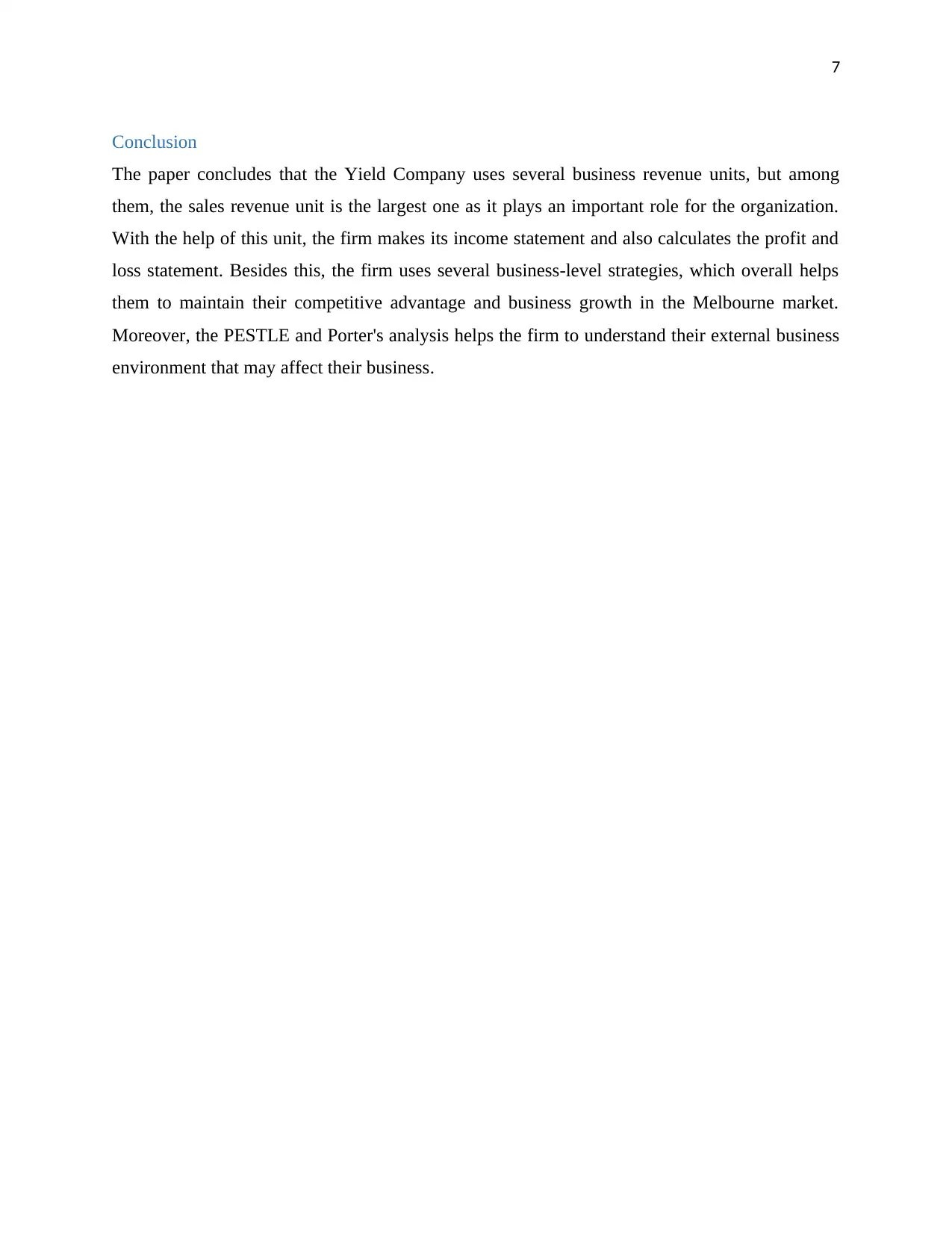
7
Conclusion
The paper concludes that the Yield Company uses several business revenue units, but among
them, the sales revenue unit is the largest one as it plays an important role for the organization.
With the help of this unit, the firm makes its income statement and also calculates the profit and
loss statement. Besides this, the firm uses several business-level strategies, which overall helps
them to maintain their competitive advantage and business growth in the Melbourne market.
Moreover, the PESTLE and Porter's analysis helps the firm to understand their external business
environment that may affect their business.
Conclusion
The paper concludes that the Yield Company uses several business revenue units, but among
them, the sales revenue unit is the largest one as it plays an important role for the organization.
With the help of this unit, the firm makes its income statement and also calculates the profit and
loss statement. Besides this, the firm uses several business-level strategies, which overall helps
them to maintain their competitive advantage and business growth in the Melbourne market.
Moreover, the PESTLE and Porter's analysis helps the firm to understand their external business
environment that may affect their business.
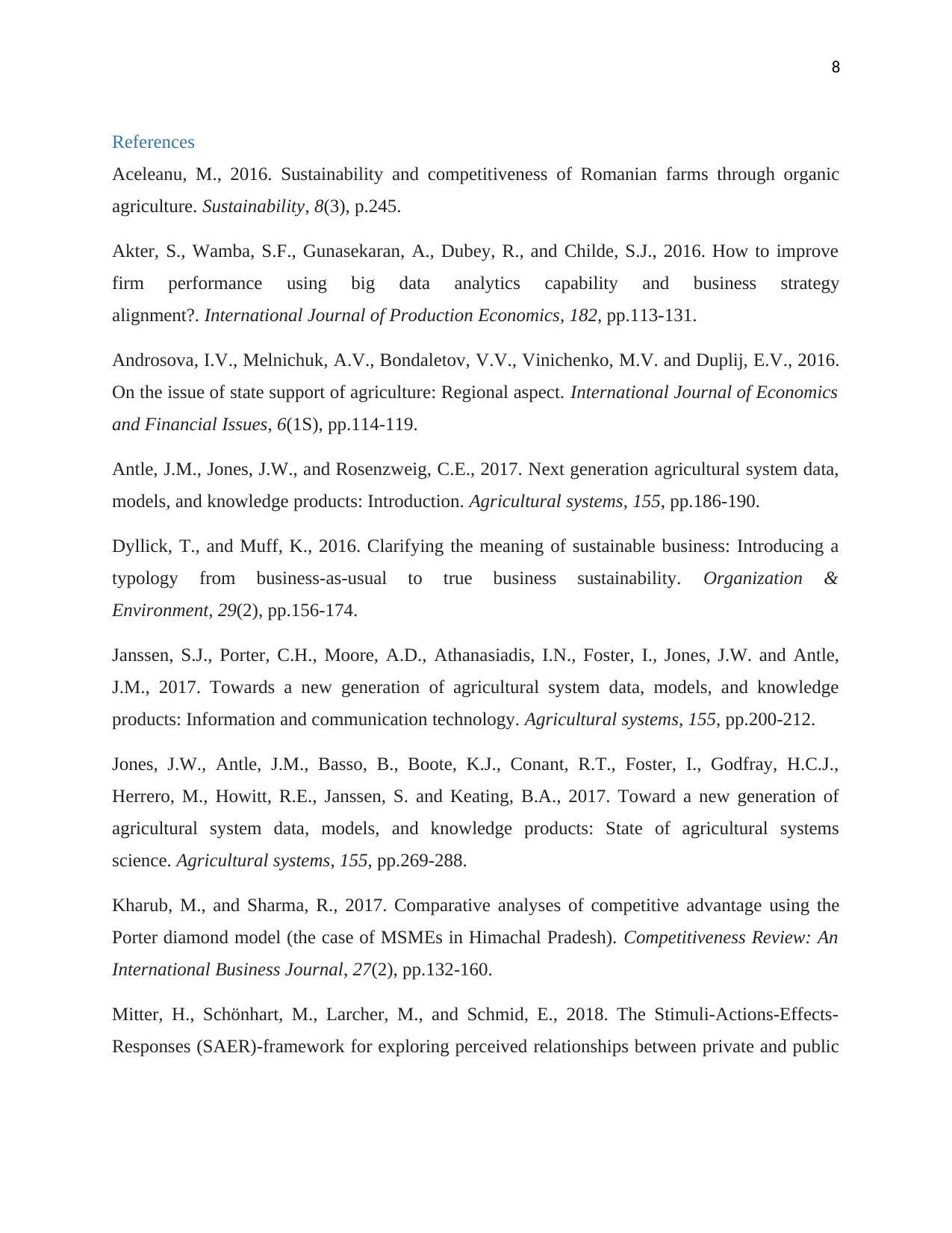
8
References
Aceleanu, M., 2016. Sustainability and competitiveness of Romanian farms through organic
agriculture. Sustainability, 8(3), p.245.
Akter, S., Wamba, S.F., Gunasekaran, A., Dubey, R., and Childe, S.J., 2016. How to improve
firm performance using big data analytics capability and business strategy
alignment?. International Journal of Production Economics, 182, pp.113-131.
Androsova, I.V., Melnichuk, A.V., Bondaletov, V.V., Vinichenko, M.V. and Duplij, E.V., 2016.
On the issue of state support of agriculture: Regional aspect. International Journal of Economics
and Financial Issues, 6(1S), pp.114-119.
Antle, J.M., Jones, J.W., and Rosenzweig, C.E., 2017. Next generation agricultural system data,
models, and knowledge products: Introduction. Agricultural systems, 155, pp.186-190.
Dyllick, T., and Muff, K., 2016. Clarifying the meaning of sustainable business: Introducing a
typology from business-as-usual to true business sustainability. Organization &
Environment, 29(2), pp.156-174.
Janssen, S.J., Porter, C.H., Moore, A.D., Athanasiadis, I.N., Foster, I., Jones, J.W. and Antle,
J.M., 2017. Towards a new generation of agricultural system data, models, and knowledge
products: Information and communication technology. Agricultural systems, 155, pp.200-212.
Jones, J.W., Antle, J.M., Basso, B., Boote, K.J., Conant, R.T., Foster, I., Godfray, H.C.J.,
Herrero, M., Howitt, R.E., Janssen, S. and Keating, B.A., 2017. Toward a new generation of
agricultural system data, models, and knowledge products: State of agricultural systems
science. Agricultural systems, 155, pp.269-288.
Kharub, M., and Sharma, R., 2017. Comparative analyses of competitive advantage using the
Porter diamond model (the case of MSMEs in Himachal Pradesh). Competitiveness Review: An
International Business Journal, 27(2), pp.132-160.
Mitter, H., Schönhart, M., Larcher, M., and Schmid, E., 2018. The Stimuli-Actions-Effects-
Responses (SAER)-framework for exploring perceived relationships between private and public
References
Aceleanu, M., 2016. Sustainability and competitiveness of Romanian farms through organic
agriculture. Sustainability, 8(3), p.245.
Akter, S., Wamba, S.F., Gunasekaran, A., Dubey, R., and Childe, S.J., 2016. How to improve
firm performance using big data analytics capability and business strategy
alignment?. International Journal of Production Economics, 182, pp.113-131.
Androsova, I.V., Melnichuk, A.V., Bondaletov, V.V., Vinichenko, M.V. and Duplij, E.V., 2016.
On the issue of state support of agriculture: Regional aspect. International Journal of Economics
and Financial Issues, 6(1S), pp.114-119.
Antle, J.M., Jones, J.W., and Rosenzweig, C.E., 2017. Next generation agricultural system data,
models, and knowledge products: Introduction. Agricultural systems, 155, pp.186-190.
Dyllick, T., and Muff, K., 2016. Clarifying the meaning of sustainable business: Introducing a
typology from business-as-usual to true business sustainability. Organization &
Environment, 29(2), pp.156-174.
Janssen, S.J., Porter, C.H., Moore, A.D., Athanasiadis, I.N., Foster, I., Jones, J.W. and Antle,
J.M., 2017. Towards a new generation of agricultural system data, models, and knowledge
products: Information and communication technology. Agricultural systems, 155, pp.200-212.
Jones, J.W., Antle, J.M., Basso, B., Boote, K.J., Conant, R.T., Foster, I., Godfray, H.C.J.,
Herrero, M., Howitt, R.E., Janssen, S. and Keating, B.A., 2017. Toward a new generation of
agricultural system data, models, and knowledge products: State of agricultural systems
science. Agricultural systems, 155, pp.269-288.
Kharub, M., and Sharma, R., 2017. Comparative analyses of competitive advantage using the
Porter diamond model (the case of MSMEs in Himachal Pradesh). Competitiveness Review: An
International Business Journal, 27(2), pp.132-160.
Mitter, H., Schönhart, M., Larcher, M., and Schmid, E., 2018. The Stimuli-Actions-Effects-
Responses (SAER)-framework for exploring perceived relationships between private and public

9
climate change adaptation in agriculture. Journal of environmental management, 209, pp.286-
300.
Prokhorova, V.V., Klochko, E.N., Kolomyts, O.N. and Gladilin, A.V., 2016. Prospects of the
agro-industrial complex development: economic diversification, business development, mono-
industry town strengthening, and expansion. International review of management and
marketing, 6(6S), pp.159-164.
Pyatt, F.B., Kennedy, R.D.P., and Kennedy, E.M.P., 2018. An appraisal of sample preparation,
analysis, and some toxicological implications of ancient industrial metalliferous pollution.
International Journal of Environmental Studies, 75(3), pp.518-531.
The Yield Company, (2019). Australian AgTech & The Yield | The Yield. [online] Available at
https://www.theyield.com/our-company/the-yield-story [Accessed 6 Jun. 2019].
climate change adaptation in agriculture. Journal of environmental management, 209, pp.286-
300.
Prokhorova, V.V., Klochko, E.N., Kolomyts, O.N. and Gladilin, A.V., 2016. Prospects of the
agro-industrial complex development: economic diversification, business development, mono-
industry town strengthening, and expansion. International review of management and
marketing, 6(6S), pp.159-164.
Pyatt, F.B., Kennedy, R.D.P., and Kennedy, E.M.P., 2018. An appraisal of sample preparation,
analysis, and some toxicological implications of ancient industrial metalliferous pollution.
International Journal of Environmental Studies, 75(3), pp.518-531.
The Yield Company, (2019). Australian AgTech & The Yield | The Yield. [online] Available at
https://www.theyield.com/our-company/the-yield-story [Accessed 6 Jun. 2019].
1 out of 10
![[object Object]](/_next/static/media/star-bottom.7253800d.svg)





